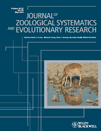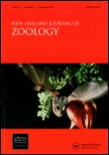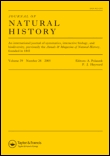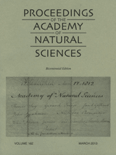
TAIWANIA
Scope & Guideline
Advancing ecological knowledge, one discovery at a time.
Introduction
Aims and Scopes
- Biodiversity Documentation:
The journal publishes extensive research on new species discoveries and taxonomic revisions, contributing significantly to the knowledge of flora and fauna in Asia, particularly in Taiwan, the Philippines, Vietnam, and surrounding regions. - Ecological Studies:
Research in TAIWANIA often includes ecological assessments, habitat preferences, and the interaction of species within their environments, providing insights into biodiversity conservation and ecological dynamics. - Molecular Phylogenetics:
A notable focus on molecular techniques to resolve taxonomic ambiguities and understand evolutionary relationships among species, facilitating clearer classifications and species descriptions. - Conservation Biology:
The journal emphasizes the importance of conservation strategies and ecological sustainability, often highlighting studies that assess the impact of anthropogenic activities on biodiversity. - Citizen Science Contributions:
TAIWANIA encourages the involvement of citizen science in biodiversity monitoring, showcasing studies that utilize citizen-collected data to enhance understanding of species distributions and conservation priorities.
Trending and Emerging
- Species Discovery and Description:
An increasing number of papers are focused on the discovery and formal description of new species, reflecting an ongoing commitment to documenting biodiversity, especially in underexplored regions. - Molecular Techniques in Taxonomy:
There is a significant trend towards the use of molecular techniques, such as DNA barcoding and phylogenetic analysis, to resolve taxonomic issues and provide deeper insights into species relationships. - Ecological and Environmental Assessments:
Research related to ecological assessments and the impact of environmental changes on species distribution is on the rise, indicating a growing emphasis on understanding biodiversity in the context of climate change and habitat alteration. - Conservation Strategies and Biodiversity Hotspots:
Papers addressing conservation strategies in biodiversity hotspots are increasingly prominent, emphasizing the need for practical approaches to preserve endemic species and their habitats. - Citizen Science Engagement:
The incorporation of citizen science in biodiversity studies is emerging as a significant theme, reflecting a shift towards collaborative approaches in data collection and conservation efforts.
Declining or Waning
- Traditional Taxonomic Studies:
There seems to be a decline in purely traditional taxonomic studies that do not incorporate molecular techniques. As molecular phylogenetics gains traction, the reliance on morphological studies alone is decreasing. - General Flora Surveys:
There is a notable reduction in the publication of broad flora surveys that do not focus on specific regions or new species discoveries, as the journal shifts towards more detailed and targeted studies. - Invasive Species Research:
Research focusing solely on invasive species without a broader ecological context appears to be declining, as the journal now favors studies that integrate invasive species within comprehensive ecological frameworks.
Similar Journals

REVUE SUISSE DE ZOOLOGIE
Unveiling Nature's Secrets Through ResearchThe REVUE SUISSE DE ZOOLOGIE, published by the esteemed MUSEUM HISTOIRE NATURELLE, is a premier journal dedicated to advancing the field of zoology and its related disciplines. Established in 1964, this Swiss journal has consistently provided a platform for high-quality research in the areas of ecology, evolution, behavior, and systematics, currently holding a commendable Q3 ranking in these categories for 2023. With a rich publication history spanning from 1964 to 1979 and then from 1994 to the present, it serves not only as a significant repository of knowledge but also as a crucial resource for researchers, professionals, and students alike. While the journal is not open access, it remains a vital tool for those wishing to stay at the forefront of zoological research and innovation. Its commitment to disseminating groundbreaking studies makes it an indispensable asset for academic institutions and researchers globally, ensuring that pivotal findings in zoology continue to gain visibility and impact.

JOURNAL OF ZOOLOGICAL SYSTEMATICS AND EVOLUTIONARY RESEARCH
Pioneering Discoveries in Zoology and EcologyThe Journal of Zoological Systematics and Evolutionary Research, published by Wiley-Hindawi, stands as a premier academic journal since its establishment, showcasing cutting-edge research in the fields of Animal Science, Zoology, and Ecology. With an impressive track record spanning from 1963 to the present, this journal has earned a Q1 classification in both Animal Science and Ecology, as well as recognized rankings in Genetics and Molecular Biology. Its impact is highlighted by its Scopus ranks, placing it in the top percentile for relevant categories, underscoring its vital role in advancing knowledge and understanding within these disciplines. Researchers, professionals, and students will find a wealth of high-quality, peer-reviewed articles that contribute to the evolutionary understanding of biodiversity and systematics. Though not an Open Access journal, it remains accessible to a wide audience committed to exploring the intricacies of zoology and evolutionary biology.

AUSTRALIAN JOURNAL OF BOTANY
Bridging knowledge and conservation for a greener tomorrow.The Australian Journal of Botany is a prestigious peer-reviewed journal published by CSIRO PUBLISHING, dedicated to advancing the field of plant sciences and ecology. Established in 1953, this journal provides a critical platform for researchers to share original research findings, reviews, and perspectives in subjects ranging from plant biology to ecological interactions, with a focus on Australian flora and its conservation. With an impressive impact factor and categorized in the Q3 quartile in both Ecology, Evolution, Behavior and Systematics and Plant Science, the journal ranks competitively within its fields, allowing authors to reach a diverse audience of professionals, students, and fellow researchers. The journal is accessible in print and electronically through its ISSN: 0067-1924 and E-ISSN: 1444-9862, providing wider access to vital research outcomes that influence environmental policies and natural resource management. As it aspires towards innovation and excellence, the Australian Journal of Botany remains an essential resource for those passionate about the richness of plant biodiversity and ecological understanding.

SPIXIANA
Advancing the Frontiers of Animal ScienceSPIXIANA is a distinguished journal dedicated to the fields of animal science and zoology, published by VERLAG DR FRIEDRICH PFEIL in Germany. With the ISSN 0341-8391, it has been contributing to the scientific community since its inception, with volumes converging from 2008 to 2024. Although currently listed in the Q4 quartile of the 2023 category rankings for Animal Science and Zoology, it provides a vital platform for researchers and professionals to disseminate significant findings in the field. Despite being unindexed in open access, SPIXIANA ensures that vital research reaches its audience, enhancing academic discourse and furthering our understanding of zoological sciences. Its commitment to sharing rigorous scientific research make it an important resource for anyone passionate about animal biology and conservation.

BIOTA NEOTROPICA
Advancing Ecological Insights for a Sustainable FutureBIOTA NEOTROPICA is a prominent open access journal dedicated to advancing knowledge in the interdisciplinary field of ecology, evolution, behavior, and systematics. Published by REVISTA BIOTA NEOTROPICA since 2001, this Brazilian journal aims to provide a platform for high-quality research that fosters a deeper understanding of Neotropical biodiversity and its conservation. With an ISSN of 1676-0603 and an E-ISSN of 1676-0611, the journal has established its reputation within academic circles, ranking in the Q3 quartile for Ecology and achieving a respectable percentile of 57 in Scopus’s metrics. Operating from its headquarters in Campinas, SP, Brazil, BIOTA NEOTROPICA not only focuses on research dissemination but also encourages collaboration and exchange of ideas among scientists, students, and professionals in the field. The journal is particularly valuable for those looking to contribute to the understanding of ecological systems and promotes accessibility with its open access model.

NEW ZEALAND JOURNAL OF ZOOLOGY
Pioneering Insights into Animal Behavior and Ecology.NEW ZEALAND JOURNAL OF ZOOLOGY, published by Taylor & Francis Ltd, offers a crucial platform for the dissemination of high-quality research in the field of zoology and animal science. With an ISSN of 0301-4223 and an E-ISSN of 1175-8821, this journal has been a valuable resource since its inception in 1974 and continues to contribute significantly to the academic community, with a converged years span extending to 2024. The journal holds a commendable Q3 ranking in the 2023 category of Animal Science and Zoology, and ranks #175 out of 490 in Scopus, placing it in the 64th percentile of its category. While it is not an Open Access journal, researchers can still access a wide range of studies that delve into various aspects of zoology. With its robust editorial standards and commitment to advancing knowledge in animal science, the NEW ZEALAND JOURNAL OF ZOOLOGY serves as an essential resource for researchers, professionals, and students interested in the complexities of wildlife and ecological studies.

JOURNAL OF NATURAL HISTORY
Pioneering Insights into Natural SystemsThe Journal of Natural History, established in 1967, is a pivotal academic resource published by Taylor & Francis Ltd. With an ISSN of 0022-2933 and an E-ISSN of 1464-5262, this journal is a cornerstone in the field of Ecology, Evolution, Behavior, and Systematics. Ranked Q2 in its category as of 2023, it stands out with a Scopus ranking of #477 out of 721, reflecting its influence and relevance, particularly in the agricultural and biological sciences. The Journal of Natural History aims to disseminate high-quality, peer-reviewed research that contributes to our understanding of biodiversity and ecosystem dynamics. Although it does not operate under an open-access model, this journal remains accessible through various academic libraries and platforms, making it an essential resource for researchers, professionals, and students striving to advance their knowledge in natural history. With its long-standing commitment to excellence, the journal plays a crucial role in shaping discourse and fostering innovation in ecological research.

PROCEEDINGS OF THE ACADEMY OF NATURAL SCIENCES OF PHILADELPHIA
Connecting research with environmental impact.PROCEEDINGS OF THE ACADEMY OF NATURAL SCIENCES OF PHILADELPHIA, published by the Academy of Natural Sciences of Philadelphia, is a prominent journal in the field of ecological sciences, offering a platform for groundbreaking research and discoveries that enhance our understanding of natural systems. With an ISSN of 0097-3157, this journal contributes rich insights into various ecological disciplines, from behavioral studies to systematics, as evidenced by its Scopus rankings and Q4 quartile placements in Ecology and Ecology, Evolution, Behavior and Systematics. The journal is committed to fostering a collaborative academic environment and aims to disseminate high-quality research that influences environmental policies and conservation strategies. Although it does not primarily operate under an open-access model, it serves as an essential resource for researchers, professionals, and students keen on advancing their knowledge in ecological research and natural history.

TELOPEA
Elevating Knowledge in Ecology and Plant SciencesTELOPEA is a distinguished scholarly journal published by the Natl Herbarium New South Wales, focusing on the rich fields of Ecology, Evolution, Behavior, and Systematics, as well as Plant Science. With an ISSN of 0312-9764 and an E-ISSN of 2200-4025, the journal has been a significant contributor to the understanding of plant biodiversity and ecosystem dynamics since its inception in 1984, with regular publication resuming in 2006 through to 2024. Residing in the beautiful Australian Botanic Garden at Mount Annan, NSW, TELOPEA operates under a Q3 ranking for both Ecology and Plant Science as of 2023, reflecting its relevance and contribution to these critical scientific disciplines. Though it does not offer open access, the journal remains an essential resource for researchers and professionals seeking to contribute to and stay abreast of the latest developments in plant sciences and ecological research. With a commitment to rigorous peer review and the dissemination of high-quality research, TELOPEA stands as a vital platform for advancing knowledge in the realm of plant ecology and systematics.

European Journal of Taxonomy
Bridging science and society in the realm of taxonomy.The European Journal of Taxonomy is a distinguished open access journal, published by the MUSEUM NATL HISTOIRE NATURELLE in France, dedicated to the rich and dynamic field of taxonomy, ecology, and systematics. Since its inception in 2011, this journal has aimed to provide a platform for the dissemination of high-quality research and innovative methods relevant to the study of biodiversity and species classification. With a commendable Q2 ranking in the Ecology, Evolution, Behavior and Systematics category as of 2023, the journal ranks 380 out of 721 in Scopus, highlighting its pivotal role in advancing scientific knowledge in these essential areas. Researchers and students alike will find valuable resources and contributions that address pressing ecological and evolutionary questions from 2015 to 2024. By promoting open access, the European Journal of Taxonomy ensures that vital research is accessible to a broader audience, fostering collaboration and discourse among professionals striving to enhance our understanding of the natural world.